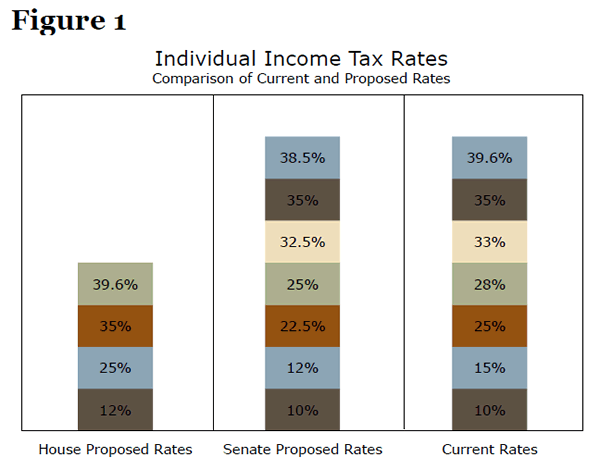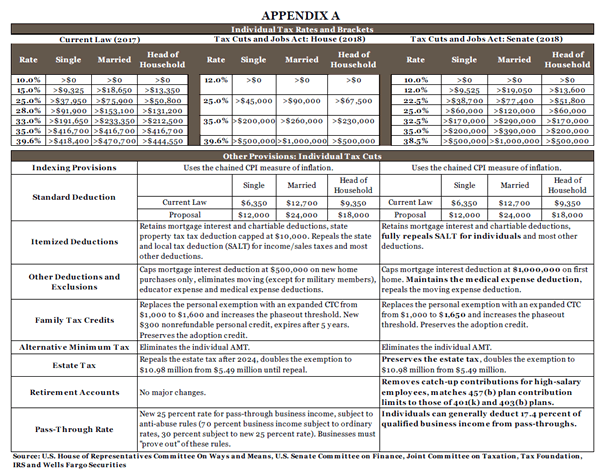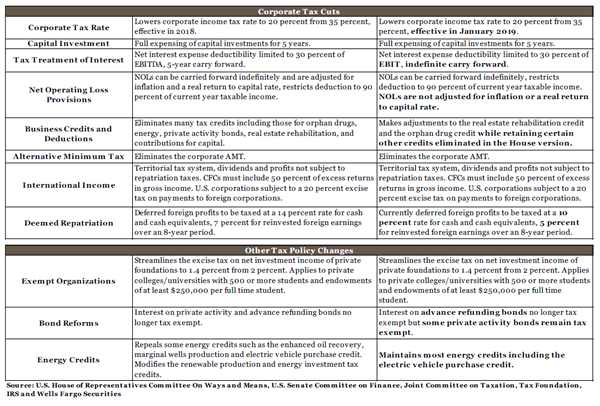Executive Summary
Last week marked a key milestone in Congressional Republicans’ efforts to pass a tax overhaul plan in advance of next year’s midterm elections. The House Ways and Means Committee passed its version of a tax package, which we expect to pass a full House vote. In the other chamber, the Senate Finance Committee released the details of its tax plan, which differed in several key ways from the House package. The Senate plan is still more fluid and is likely to change as it winds its way through the mark-up process this week. In this report, we summarize the key differences between the House and Senate tax packages and discuss some of the key policy sticking points that we foresee as the major challenges to the completion of a final tax package.
We remain comfortable with our call for passage of a tax package in the first quarter of next year, with the cuts retroactive to January 2018. Our view is that the final package will need to be smaller and less permanent than what is currently being proposed in order to 1) comply with Senate rules for passage through budget reconciliation and 2) be politically viable in both the House of Representatives and the Senate, where the priorities and political incentives are somewhat different.
Comparing the House and Senate Tax Plans
For a full summary table comparing the House and Senate tax plans see Appendix A.
Individual Side of the Tax Code

Tax Brackets
House: Collapses the current seven brackets into four brackets of 12, 25, 35 and 39.6 percent. The marginal rate on the top bracket is left unchanged and would kick in at income in excess of $500,000 for single filers and $1,000,000 for married filers, up from $418,400 and $470,700 currently. The tax brackets (and other inflation-adjusted tax parameters) would be indexed for inflation using chained CPI rather than CPI-U.
Senate: Leaves the number of tax brackets at seven but modifies the rates and income thresholds. The marginal rate on the top bracket is reduced to 38.5 percent and would kick in at income in excess of $500,000 for single filers and $1,000,000 for married filers. The tax brackets (and other inflation-adjusted tax parameters) would be indexed for inflation using chained CPI rather than CPI-U.
Standard Deduction
House: Nearly doubles the standard deduction for single and married filers.
Senate: Same as House plan.
Personal Exemption
House: Eliminates the personal exemption.
Senate: Same as House plan.
Alternative Minimum Tax
House: Eliminates the Alternative Minimum Tax (AMT).
Senate: Same as House plan.
Estate Tax
House: Doubles the estate tax exemption to $10.98 million, indexed to inflation, then permanently repeals the estate tax in 2024.
Senate: Preserves the estate tax and doubles the exemption to $10.98 million, indexed to inflation. Keeping the estate tax on a permanent basis is likely to be a point of contention for the most conservative House and Senate members, who have long championed eliminating the estate tax.
Retirement Plans
House: No major changes.
Senate: Eliminates catch-up contributions for high-wage (>$500,000) workers 50 and over and consolidates contribution limits for 457(b)s to match 401(k)s and 403(b)s. These are much smaller changes than initially considered in the House, but they do represent another potential politically sensitive topic for policymakers.
Child/Family Tax Credits
House: Increases child tax credit to $1,600 from $1,000 and increases income threshold for phase-out. Creates a new $300 per-person family tax credit for other non-child dependents. This new credit expires after 2022. The temporary nature of this tax credit could be a possible point of contention. Sun setting this provision helps save money from a budget score perspective, but it has raised questions from some about how this will effect families’ tax bills down the road. Given how politically popular a family tax credit could prove to be, policymakers are likely banking that the credit would be extended past 2022 when the time eventually comes.
Senate: Increases child tax credit to $1,650 and increases income threshold for phase-out to a greater extent than the House plan. Creates a $500 nonrefundable credit for qualifying dependents other than children.
Itemized Deductions
House: Eliminates the deduction for state & local income/sales taxes, but retains the state & local property tax deduction with a cap of $10,000. Caps mortgage interest deduction at $500,000 of debt (down from $1 million under current law), eliminates the interest deduction for second homes and home equity debt. Eliminates the medical expense deduction.
Senate: Fully repeals the state & local deduction for both income and property taxes. Repeals the deduction for interest on home equity debt but otherwise leaves mortgage interest deduction unchanged. Retains the medical expense deduction. Broadly speaking, the Senate plan takes a less aggressive approach to eliminating deductions in the individual side of the tax code, but helps make up some of the lost revenue through a full repeal of the state & local deduction. The more aggressive state & local deduction approach is likely to cause problems in the House, where Republican members from high-tax, high cost-of-living areas have raised concerns over full elimination.
Pass-Through Income
House: Creates a 25 percent rate for income derived from pass-through entities, which under current law is taxed through individual income tax brackets. To try and prevent abuse of the system, the plan proposes treating 70 percent of income as wage income (subject to the individual tax brackets) and 30 percent as business income (subject to the 25 percent rate). Some "specific service activities," such as income derived from financial services, law, engineering and other similar fields, are excluded from the special pass-through rate to create additional anti-abuse guardrails.
Senate: Allows a deduction of 17.4 percent of qualified business income from their total income. Also excludes some "specific service activities" from taking advantage of this provision for antiabuse reasons. Policymakers have been vexed by the competing desires to provide a tax cut for small businesses who file through the individual income tax system while also preventing people from gaming the system and passing off wage income as pass-through income. The House and Senate each take much different approaches that will need to be reconciled before final passage.
Corporate Side of the Tax Code

Corporate Tax Brackets
House: Reduces the current 35 percent top statutory rate down to 20 percent with an effective date of January 1, 2018.
Senate: Reduces the current 35 percent top statutory rate down to 20 percent like the House plan but delays the implementation until January 1, 2019 in order to save room under the revenue reduction cap of $1.5 trillion over 10 years. The one year delay of the corporate tax rate reduction is a possible point of contention not just with the House of Representatives but also with the White House. The reduction of the corporate rate to 20 percent creates the biggest decrease in revenues in the House and Senate plans, reducing revenues by $1.46 trillion and $1.33 trillion, respectively, over 10 years on a static basis according to the Joint Committee on Taxation.
Capital Investment
House: Allows for full expensing of certain capital investment for 5 years.
Senate: Same as House plan.
Tax Treatment of Interest
House: Limits net interest expense deductibility to 30 percent of earnings before interest, taxes, depreciation, and amortization (EBITDA).
Senate: Limits net interest expense to 30 percent of earnings before interest and taxes (EBIT).
Net Operating Loss Provisions
House: Eliminates net operating loss (NOL) carryback while allowing for net operating loss carryforwards (adjusted for inflation and the real return to capital) but restricts the deduction to 90 percent of current year taxable income.
Senate: Eliminates net operating loss (NOL) carryback but restricts the deduction to 90 percent of current year taxable income. The senate version does not make an adjustment for inflation and the real return to capital.
Business Credits and Deductions
House: Eliminates many tax credits including those for orphan drugs, energy, private activity bonds, real estate rehabilitation, and contributions for capital.
Senate: Makes adjustments to the real estate rehabilitation credit and the orphan drug credit while retaining certain other credits eliminated in the House version.
Alternative Minimum Tax
House: Eliminates the corporate AMT.
Senate: Same as House plan.
International Income
House: Establishes a territorial tax system in which foreign-source dividends and profits of U.S. companies are not subject to U.S. tax upon repatriation. However, 50 percent of excess returns (those greater than a routine return, defined as the applicable federal rate plus 7 percent) earned by controlled foreign corporations (CFCs) are included in U.S. shareholders’ gross income.
Senate: Moves to a territorial system with a minimum tax of the excess of 10 percent of modified taxable income over an amount equal to the firm’s regular tax liability.
Deemed Repatriation
House: Enacts a deemed repatriation of deferred foreign profits at a rate of 14 percent for cash and cash-equivalent profits and 7 percent for reinvested foreign earnings over a period of eight years.
Senate: Enacts a deemed repatriation of deferred foreign profits at a rate of 10 percent for cash and cash-equivalent profits and 5 percent for reinvested foreign earnings over a period of eight years.
Legislative Outlook: A Long Road Ahead
What are the next steps in getting a tax package passed through Congress and sent to the President’s desk for signature? The next couple of weeks will be dominated by the House trying to pass its package via a full floor vote while the Senate Finance Committee marks up its package to garner enough votes for passage through both the committee process and a full Senate floor vote. While it is likely that the House will pass their package rather quickly, we are skeptical that the Senate will move as quickly. As was on display during the Senate Republican efforts to repeal and replace the Affordable Care Act, the legislative progress in the Senate is much more challenging due to a combination of ideological differences and a very tight vote margin for legislation passing with only Republican votes.
Complicating the process in the Senate is an impending deadline to fund the government beyond December 8. Senate leadership has indicated that they may delay a planned recess for the week of November 20 in order to pass their tax package. That plan, however, assumes that the Senate Finance Committee is able to finish its work and get a bill to the Senate floor. There are two different ways in which a tax package can be enacted from this point forward. First, the Senate can make changes to its package that are acceptable to the House. The House could then take up the Senate plan as is, vote on it and send it to the president upon passage. Alternatively, the House and Senate could pass their own plans and then go to conference committee to work out the differences.
Taking a step back, it is important to understand why the procedural hurdles are likely to slow the process down. In order to use the privileged reconciliation process to pass legislation with just 51 votes in the Senate, Republicans must subject themselves to a series of Senate rules that essentially require them to pick just two of the following three options: enact sizable gross tax cuts, maintain popular tax breaks and achieve permanence for the changes. It is possible, for instance, to pass sweeping tax cuts while maintaining popular tax breaks such as the mortgage interest deduction and the deduction for state & local taxes, but Senate rules would almost certainly make it so that these tax cuts must have an expiration date, be phased-in, or some combination of the two. Alternatively, policymakers could choose the permanent/maintain big tax breaks combination, but this would mean the gross tax cuts that have been proposed would have to be scaled back.
The most recent scores from the Joint Committee on Taxation, the official scorekeeper for Congress on revenue matters, estimate the FY 2027 budget deficit (the last year of the budget window) would be $155.6 billion under the House plan and $216.7 billion under the Senate plan. These deficit estimates suggest budget deficits will continue past the budget window, a violation of Senate reconciliation rules and an elephant in the room that policymakers have still yet to address.
As can be seen, the two pieces of legislation are quite far apart on a number of key policy issues. Regardless of whether these differences are resolved in the final Senate package or through a conference committee, we maintain the view that the final package will contain smaller and less permanent tax cuts than what is currently being proposed. In addition, we still expect the timeline to be final passage of a tax package in Q1 2018, with the cuts retroactively beginning in January 2018.
Appendix A in pdf.














